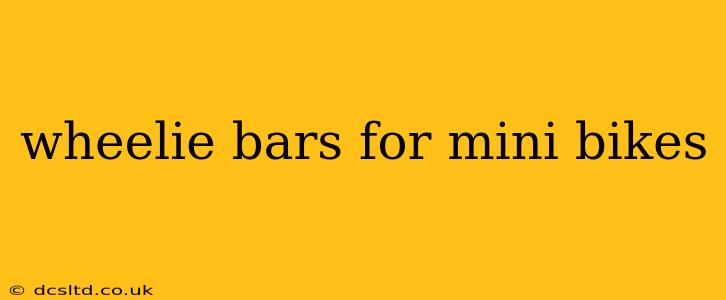Mini bikes, with their compact size and powerful engines, offer thrilling rides. However, their lightweight nature can lead to uncontrolled wheelies, posing a significant safety risk. This is where wheelie bars come in, providing crucial stability and control, particularly for beginners and those tackling challenging terrain. This comprehensive guide will explore everything you need to know about wheelie bars for mini bikes, addressing common questions and concerns.
What are Wheelie Bars and How Do They Work?
Wheelie bars are essentially stabilizing devices attached to the rear of a mini bike. They consist of two bars extending downward, usually equipped with adjustable feet or wheels that make contact with the ground. When the front wheel lifts off the ground, the wheelie bars prevent a complete wheelie by providing a counterbalance, keeping the bike stable and controllable. They act as a safety mechanism, preventing accidents and allowing riders to focus on maneuvering the bike. The design varies depending on the mini bike model and rider preference, but the fundamental principle remains the same: maintaining rear-end stability.
What are the Benefits of Using Wheelie Bars on a Mini Bike?
The primary benefit is significantly improved safety. By preventing uncontrolled wheelies, wheelie bars reduce the risk of accidents, falls, and injuries. Beyond safety, they offer several other advantages:
- Enhanced Control: Wheelie bars provide more predictable handling, especially during acceleration and on uneven surfaces. This is particularly helpful for novice riders.
- Increased Stability: The added weight and contact with the ground provide greater stability, making the bike less prone to tipping or losing traction.
- Improved Traction: By transferring some weight to the rear, wheelie bars can improve rear-wheel traction, especially during acceleration.
- Longer Lifespan for Parts: By preventing harsh landings after wheelies, wheelie bars protect the mini bike's components from damage.
What are the Different Types of Wheelie Bars?
There's a range of wheelie bar designs available, each with its own advantages and disadvantages:
- Fixed Wheelie Bars: These are simple, non-adjustable bars offering basic stability. They're generally more affordable but less versatile.
- Adjustable Wheelie Bars: These offer adjustable height settings, allowing customization based on riding conditions and rider preference. This offers better adaptability to various terrains and riding styles.
- Wheelie Bar Kits: Many manufacturers offer complete kits that include everything needed for installation. These kits often include mounting hardware and instructions, simplifying the installation process.
How Do I Install Wheelie Bars on My Mini Bike?
The installation process varies depending on the specific wheelie bar design and your mini bike model. Always consult the manufacturer's instructions for precise guidance. Generally, installation involves:
- Measuring and Marking: Accurately measuring the mounting points on your mini bike is crucial for proper alignment and stability.
- Mounting: Securely attaching the wheelie bars to the mini bike frame, usually using bolts and brackets.
- Adjustment: Adjusting the height of the wheelie bars to achieve the desired ground clearance and stability.
Are Wheelie Bars Necessary for All Mini Bikes?
While not strictly mandatory, wheelie bars are highly recommended, particularly for:
- Beginner Riders: They provide extra stability and help prevent accidents.
- Powerful Mini Bikes: High-performance engines are more likely to cause uncontrolled wheelies.
- Off-Road Riding: Uneven terrain increases the risk of wheelies.
How Do I Choose the Right Wheelie Bars for My Mini Bike?
Consider these factors when selecting wheelie bars:
- Mini Bike Model: Ensure compatibility with your specific mini bike's frame and design.
- Adjustability: Adjustable bars offer greater versatility.
- Material: Look for durable, high-quality materials like steel or aluminum.
- Weight: Consider the weight of the wheelie bars to avoid negatively impacting the bike's handling.
Can I Make My Own Wheelie Bars?
While possible, fabricating your own wheelie bars requires welding and metalworking skills. It's generally recommended to purchase commercially available wheelie bars to ensure proper design, safety, and durability. Improperly constructed wheelie bars could compromise safety.
By understanding the benefits, types, and installation of wheelie bars, you can significantly enhance the safety and control of your mini bike riding experience. Remember always to prioritize safety and ride responsibly.
